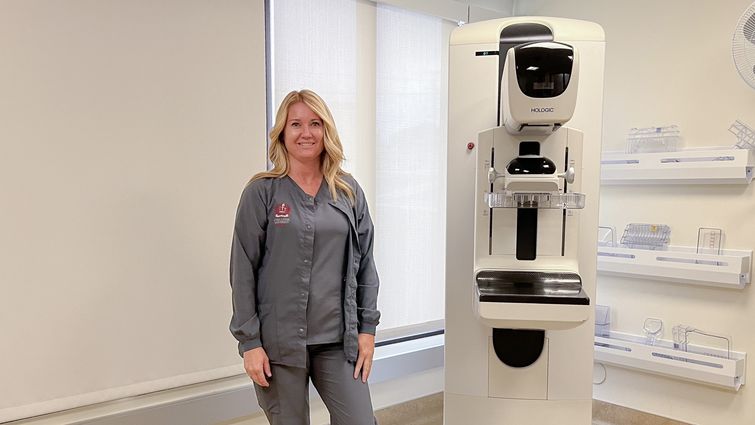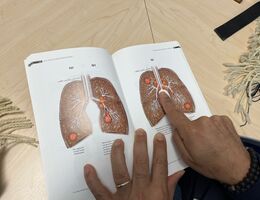
Heather Underwood, a mammography technician, stands next to a mammography machine at LLUH Women's Imaging Center. She encourages patients to relax and communicate during their mammogram appointments.
Increasing rates of breast cancer screening in the past three decades have decreased death rates for breast cancer, according to the Centers for Disease Control and Prevention. A mammogram is a relatively low dose X-ray of the breast that can find cancer early when it is easier to treat. Mammograms are the first line screening tool for breast cancer. Certain high-risk patients may also benefit from other imaging tools for screening.
For October’s Breast Cancer Awareness Month, a radiologist and a mammogram technician discuss steps patients should take to ensure the screening experience goes as smoothly as possible.
Get our newsletter for cancer-fighting tips, activities and recipes. Subscribe
There are a few simple steps patients should take to set themselves up for a successful exam even before they arrive for their mammogram, says Cherie Cora, MD, a radiologist and breast imaging specialist at Loma Linda University Health (LLUH).
Ensure continuity. Bring prior imaging.
One of the most critical factors for successful screening is maintaining uniformity and continuity in imaging over time. Ideally, Cora recommends patients repeat mammograms at the same facility to have a uniform experience, possibly even with the same technologist performing the patient’s exam each time.
If, for whatever reason, a patient needs to change where they get their mammograms done, Cora urges patients to obtain their prior images from their former facility to provide to the current facility. Providing prior images (at least two years’ worth or more) serves as a critical tool for making diagnoses, Cora says. Without priors, the radiologists do not know what the patient’s breast tissue may look like normally. Therefore, priors also help patients avoid unnecessary callbacks for further imaging.
“Prior breast imaging exams are the richest resource we have to interpret current images most accurately,” Cora says. “Without priors, patients may get called back for something that’s been stable for many years. Unnecessary callbacks waste patients’ time and take diagnostic imaging appointments from people who actually have new findings that need further evaluation. For everyone's sake, bring your priors.”
Prepare
Cora says mammograms require relatively little preparation. She says one aspect to keep in mind is to avoid wearing deodorant for the screening because it can interfere with the imaging. If patients forget, imaging clinics provide wipes to remove deodorant. LLUH also provides wipes that re-apply deodorant after a screening.
Finally, Cora says each person is different regarding how their breasts respond to pressure, with some more prone to discomfort than others. Some patients who anticipate discomfort take light pain medication before their appointment. Ultimately, Cora says the screening lasts a few seconds and should not be unbearably painful.
Read: Breast cancer expert shares four ways to lower risk, catch cancer early
The two key actions patients can take during a mammogram appointment are to relax and communicate, says Heather Underwood, a mammography technician at LLUH. She says the two go hand in hand.
Relax
In the near-decade that she has been a mammography technician (the principal clinician interacting with the patient throughout the screening), Underwood says she has commonly seen patients attend appointments with feelings of nervousness, stress, or fear. However counter-intuitive it may feel at first, Underwood encourages patients to step into the clinic with as calm and positive of an attitude as possible — it optimizes the imaging.
“Most people come in tense, with their shoulders up,” she says. “For the screening, I ask patients to put their shoulders down and relax. The more still and calm the patient is, the better the outcome for the quality of the image.”
She recommends patients bring soothing music or crafts to focus on in the waiting room.
Read: What’s possible when catching breast cancer early? One patient’s journey
Communicate
Patients can ease worries or concerns by communicating openly with their mammogram technician. Underwood says she speaks to patients as soon as she meets with them — whether it involves conversations about hobbies and family or addressing the patient’s questions and concerns with the screening process. Next, she says she explains each step of the process to the patient so they know its importance and what to expect. At LLUH, mammogram technicians spend up to 20 minutes with each patient, allowing plenty of time for conversation and questions, Underwood says.
“We get to take our time through the mammogram with each patient,” she says. “I make sure every person is comfortable from when they first come in for screening to when they leave.”
Get our newsletter for cancer-fighting tips, activities and recipes. Subscribe
At Loma Linda University Cancer Center, physicians are committed to providing patients with compassionate, comprehensive, and personalized care that gives them the best opportunity to diagnose and overcome breast cancer. Learn more about breast cancer care at the Cancer Center online or call 1-800-782-2623.


